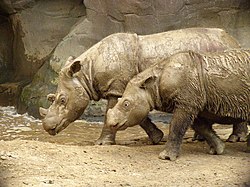Sumatran rhinoceros
| Sumatran rhinoceros[1] | |
|---|---|

| |
| Sumatran rhinoceroses Emi and Harapan in the Cincinnati Zoo | |
Conservation status
| |
| Scientific classification | |
| Kinrick: | Animalia |
| Phylum: | Chordata |
| Cless: | Mammalia |
| Order: | Perissodactyla |
| Faimily: | Rhinocerotidae |
| Genus: | Dicerorhinus Gloger, 1841 |
| Species: | D. sumatrensis |
| Binomial name | |
| Dicerorhinus sumatrensis | |
| Subspecies | |
| |
The Sumatran rhinoceros, kent as the hairy rhinoceros or Asie twa-horned rhinoceros (Dicerorhinus sumatrensis) an aw, is a rare member o the faimily Rhinocerotidae an ane o five extant rhinoceroses. It is the anerly extant species o the genus Dicerorhinus. It is the smawest rhinoceros, awtho it is still a lairge mammal; it staunds 112–145 cm (3.67–4.76 ft) heich at the shouder, wi a heid-an-bouk lenth o 2.36–3.18 m (7.7–10.4 ft) an a tail o 35–70 cm (14–28 in). The wicht is reportit tae range frae 500 tae 1,000 kg (1,100 tae 2,200 lb), averagin 700–800 kg (1,500–1,800 lb), awtho thare is a single record o a 2,000 kg (4,400 lb) specimen. Lik baith African species, it haes twa horns; the lairger is the nasal horn, teepically 15–25 cm (5.9–9.8 in), whilk the ither horn is teepically a stub. A coat o reiddish-broun hair covers maist o the Sumatran rhino's bouk.
References
- ↑ Grubb, P. (2005). "Order Perissodactyla". In Wilson, D. E.; Reeder, D. M (eds.). Mammal Species of the World (3rd ed.). Johns Hopkins University Press. p. 635. ISBN 978-0-8018-8221-0. OCLC 62265494.CS1 maint: ref=harv (link)
- ↑ van Strien, N.J., Manullang, B., Sectionov, Isnan, W., Khan, M.K.M, Sumardja, E., Ellis, S., Han, K.H., Boeadi, Payne, J. & Bradley Martin, E. 2008. [https://web.archive.org/web/20120712043942/http://www.iucnredlist.org/apps/redlist/details/6553/0 Archived 2012-07-12 at the Wayback Machine Dicerorhinus sumatrensis. In: IUCN 2011. IUCN Red List of Threatened Species]. Version 2011.2.
- ↑ Rookmaaker, L. C. (1984). "The taxonomic history of the recent forms of Sumatran Rhinoceros (Dicerorhinus sumatrensis)". Journal of the Malayan Branch of the Royal Asiatic Society. 57 (1): 12–25. JSTOR 41492969. Archived frae the original on 6 October 2020. Retrieved 10 Februar 2017.
- ↑ Derived from range maps in:
- Foose, Thomas J. and van Strien, Nico (1997). Asian Rhinos – Status Survey and Conservation Action Plan. IUCN, Gland, Switzerland, and Cambridge, UK. ISBN 2-8317-0336-0.
and - Dinerstein, Eric (2003). The Return of the Unicorns; The Natural History and Conservation of the Greater One-Horned Rhinoceros. New York: Columbia University Press. ISBN 0-231-08450-1.
This map does not include unconfirmed historical sightings in Laos and Vietnam or possible remaining populations in Burma.
- Foose, Thomas J. and van Strien, Nico (1997). Asian Rhinos – Status Survey and Conservation Action Plan. IUCN, Gland, Switzerland, and Cambridge, UK. ISBN 2-8317-0336-0.

